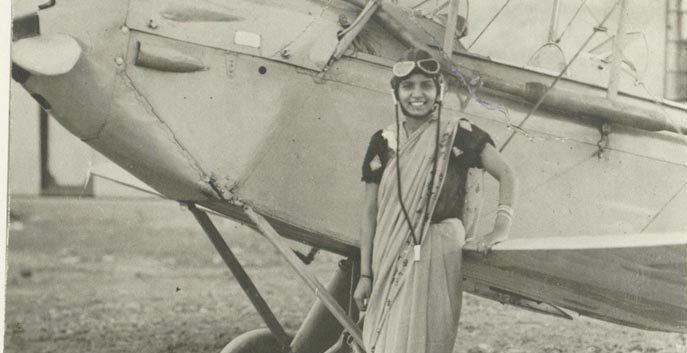Sarla Thakral was the first Indian woman to fly an aircraft. Aspirations and dreams of women in 1936 were limited, equality and women’s empowerment were merely arbitrary concepts, but Sarla proved everyone wrong. She was already living her dream in the skies, quite literally, when women were fighting for an equal status in society. She said, “I knew I was breaching a strictly male bastion, but I must say the men, they never made me feel out of place.” She never faced any opposition to her venture.
Fortunately, she had married into a progressive family of nine pilots. Her husband P.D.Sharma, whom she married at age 16, was the first man to get an airmail pilot’s license, and flew between Karachi and Lahore. He encouraged her to garner the courage to achieve her dream to fly an aircraft. His support spurred her to get trained for her solo journey. Aviation was only about men then, but Delhi born Sarla, clad in a saree, entered the cockpit of a Gypsy Moth, and made history as India’s first lady pilot in 1936, during the British rule. She was the first Indian woman to get an airmail pilot’s license, and flew between Karachi and Lahore. Dashing, courageous, and fiercely ambitious, Sarla became the new face of aviation in India, and was a fresh breeze of courage and determination, even as the mother of a four-year-old daughter.
She persevered and completed one thousand hours of flying in the aircraft owned by the Lahore Flying Club, obtaining her ‘A’ license after accumulating over 1,000 hours of flying.
Life always has something tumultuous in store for all. Soon after her flight expedition and her training at Jodhpur, her life took an ugly turn when her husband tragically died in an airplane crash in 1939, and Sarla was widowed at 24.
Shaking off the initial shock, she was then looking for the group ‘B’ license which would’ve authorised her to fly as a commercial pilot. However, World War II broke out, and civil training was suspended. This was a road block in her career, and she had to abandon her plans, and return with a broken heart.
Needing to earn her livelihood, she returned to Lahore and obtained a diploma in fine arts from the Mayo School of Arts, specialising in the Bengal school of painting. In 1947, after the partition of India, Sarla moved back to Delhi. An ardent Arya Samaj follower, life was not easy for her with two daughters, until she met R.P. Thakral, whom she married the next year.
In this second phase of life, Sarla, also known as Mati, established herself as a painter and businesswoman. She supplied her costume jewelry designs to several cottage industries for over 20 years. She also started textile printing and sari prints that did amazingly well with the fashionable crowd. One of her clients was Vijayalaxmi Pandit. She also did block printing, and designed for the National School of Drama.
She opined, “Every morning I wake up and chart out my plans. If there is plenty of work, I feel very happy; otherwise I feel a precious day has been wasted”. She insisted, “Always be happy, it is very important for us to be happy and cheerful. This one motto has seen me tide over the crises in my life.”
Sarla Thakral is truly an inspiration! A true gem, who regardless of the twists and turns in her life, lived every phase just perfectly. She represented the face of the new and confident Indian woman. She was an exemplary woman, who showed courage at a time when women feared stepping out of their homes, and faced everything in her life, fearlessly.
Sarla Thakral passed away in 2008. The India film industry needs to make a biopic on this lady who pioneered a career in aviation for women.


 [/column]
[/column]